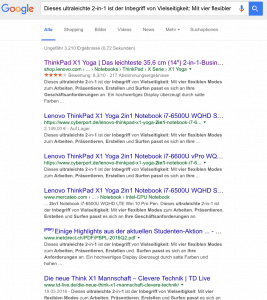Geschwindigkeit ist alles. Ob in der Beschaffung, im Service oder der Auslieferung – Betreiber von Webshops müssen schnell sein, um den heutigen Erwartungen der Kunden gerecht zu werden. Wer in einer der zahlreichen Disziplinen patzt, wird abgestraft. Schlechte Bewertungen, miese Produkttexte oder gar öffentliche Kritik über soziale Medien sind oft die Folge. Und ist der Ruf erst einmal ruiniert, ist es sehr schwer, die Gunst der kaufenden Klientel wieder zu wecken. Deshalb legen Onlinehändler viel Wert darauf, ihre Kunden erstklassig zu bedienen und einen Top-Service zu bieten.
Ein Herzstück eines jeden Online-Shops führt dabei jedoch häufig ein Schattendasein: Die zielgruppenansprechenden, informativen und konversionstarken Produkttexte. Für viele E-Commerce-Anbieter sind erstklassige Produktbeschreibungen eher ein Bremsklotz als ein Umsatzbeschleuniger.
Produkte müssen rasch in den Webshop, denn wer Produktneuheiten nicht schnell genug im Portfolio hat, lässt Umsatz liegen. Da steht das Thema Produkttexte schon mal hinten an. Viele Webshop-Betreiber sind schon froh, wenn Bildmaterial vorhanden ist. In der Konsequenz kämpfen Online-Anbieter mit diesen drei größten Herausforderungen bei der Produktbetextung:
1. Schlechte Qualität der Produkttexte
Gute Produktbeschreibungen zu produzieren und zeitnah an den Start zu bringen ist nicht nur eine Kostenfrage, sondern erfordert zudem einen wohl durchdachten Beschaffungsprozess. Zwar beschäftigen Webshop-Betreiber oft eigene Texter oder haben gar eine ganze Abteilung, welche für die Produktion von Inhalten zuständig ist, doch am Ende des Tages ist frischer Content immer ein Engpass. Dies führt regelmäßig zu Einbußen in der Qualität der Produkttexte. Nur allzu oft werden interessierte Online-Kunden mit unverständlichen und für Suchmaschinen irrelevanten Bullet-Point-Listen abgespeist.
Und Webshop-Betreiber, die sich keine eigene Content-Abteilung leisten können oder wollen, kaufen Produkttexte gerne bei Textagenturen ein. Diese Broker locken oft mit günstigen Preisen und versprechen darüber hinaus schnelle Produktion und SEO-Qualität. Die Wirklichkeit sieht oft anders aus. Kompetente und zielgruppenorientierte Produkttexte sind weder zu einem Schnäppchenpreis zu bekommen noch performen die Produktbeschreibungen in den Suchmaschinen. Wie auch?
2. Unvollständige und veraltete Produktbeschreibungen
Wenn Studenten, Hausfrauen und -männer oder Nebenerwerbler – von Textagenturen gerne als Crowd bezeichnet – unter zeitlichem Druck stehend massenweise Produkttexte runterschreiben, dann geht der Blick für das Wesentliche schnell verloren. Wichtige Eigenschaften, Funktionsbeschreibungen und vor allem der Nutzwert eines Produktes fallen gerne unter den Tisch. Sie werden mangels fachlicher Kompetenz nicht erkannt. Das ist nicht böse gemeint. Vielmehr ist es den Umständen geschuldet. Die Qualität der Produkttexte korreliert nun mal mit Zeit, Geld und Sachverstand.
Und es kommt sogar vor, dass Produktbeschreibungen eines Vorgängermodells recycelt werden. Bevor ein neues Produkt gar keinen Text hat, behilft man sich mit jenem des Vorgängermodells. Besser wäre es natürlich, die Vorteile des neuen Produktes textlich herauszuarbeiten.
3. Die Duplicate Content-Falle
Es geht sogar noch schlimmer: Der ein oder andere Betreiber eines Online-Shops greift in seiner Not auf die oft kostenlos überlassenen Marketingtexte des Herstellers zurück. Mit fatalen Folgen.
Machen wir die Probe aufs Exempel. Nehmen wir einen Auszug einer x-beliebigen Produktbeschreibung eines Herstellers und führen wir eine Google-Suche durch. Das Ergebnis ist erschreckend: Über 3.200(!) Treffer werden angezeigt, darunter eine beachtliche Anzahl an Onlineshops. Hier bleibt jegliche Individualität und Einzigartigkeit auf der Strecke – viele Webshops versinken im Einheitsbrei identisch lautender Suchergebnisse.
Wir können drei Dinge aus dem Beispiel ableiten:
- Die Verwendung von Marketingtexten im Online-Shop raubt Webshop-Betreibern jegliche Chance der eigenen Positionierung und einer individuellen Ansprache der Zielgruppe.
- Wer Marketingtexte verstärkt einsetzt, setzt sich einem nicht zu unterschätzendem Risiko aus. Der vielfache Einsatz von sogenanntem Duplicate Content schmeckt dem Suchalgorithmus von Google gar nicht – ein generell schlechteres Ranking in den Suchergebnissen ist die Folge.
- Die Verwendung von Marketingtexten schwächt die Conversion Rate eher, als dass sie dieser zuträglich ist.
Automatisierte Textgenerierung löst die Content-Handbremse
Das Spannungsfeld zwischen einerseits schnell erstellten und andererseits hochqualitativen Inhalten scheint nicht auflösbar. Und in der Tat hilft es wenig, mehr Personal, Geld und Zeit zu investieren. Denn das wirkt sich unweigerlich negativ auf Umsatz und Geschwindigkeit beim Go-to-Market aus. Gelöst werden all diese Herausforderungen jedoch durch eine automatisierte Textgenerierung.
Basierend auf den bereits vorhandenen Produktdaten und deren Attributen können Produktbeschreibungen quasi in Echtzeit produziert werden. Man darf sich das ruhig so vorstellen: Ist ein Textroboter einmal konfiguriert, werden auf einen Schlag nicht nur alle Bestandsartikel betextet, sondern künftig auch alle Produkte, welche neu ins Sortiment aufgenommen werden. Selbiges gilt ebenso für wiederkehrend zu erstellende Inhalte wie Nachrichten, Reportings, Berichte oder Analysen.
Ein Textroboter kennt den Faktor Zeit nicht, macht nie Urlaub und ist nie krank. Bei Bedarf erzeugt er 500.000 SEO-relevante und unique Texte für Ihre Zielgruppe in nur einer Stunde. Und zwar in jener Qualität und Ausprägung, die Sie vorgeben.
Weitere Beiträge zum Thema Textroboter:


